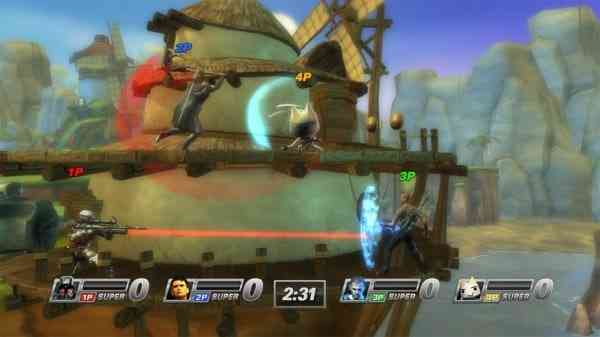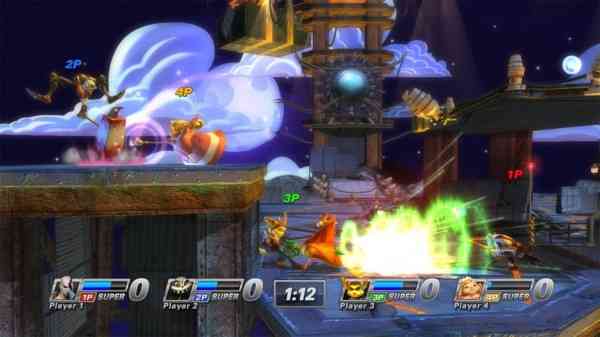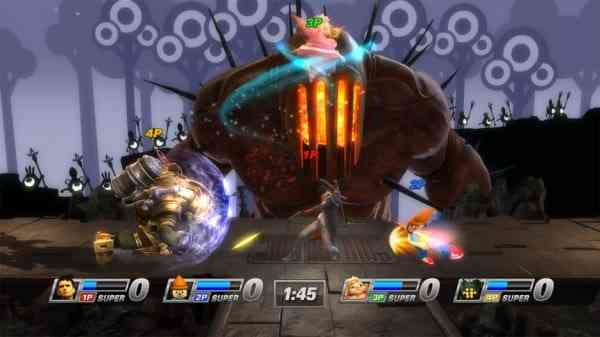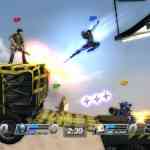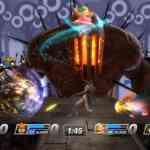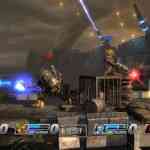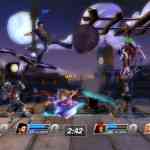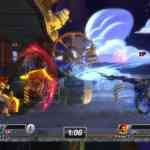When it comes to branding, Sony Computer Entertainment has constantly struggled to immortalize their more valuable PlayStation mascots within the video gaming culture. Well known PlayStation characters like Sackboy from LittleBigPlanet or Kratos from the God of War series are certainly far from unpopular and both represent very successful franchises respectively; but let’s be honest, they’ve never quite been able to attain that same level of brand recognition that Nintendo has captured over the years with it’s own iconic characters. When you think about Mario, Kirby or Link, among others, you can’t help but instantly think Nintendo. Were talking Disney level of renown here, with Mario being almost as popular and recognizable as Mickey Mouse himself.
I fear that PlayStation All-Stars Battle Royale, the new crossover fighting game codeveloped by Superbot Entertainment and SCE Santa Monica Studio, faces that same sort of dilemma. It’s no secret that All-Stars draws heavily from Super Smash Brothers in both design and format, they are conceptually the same type of fighting game. However, I question whether the PlayStation star power of All Stars will prove enough to generate adequate interest, and whether this distinction between it and Smash Brothers is really all that important in the scheme of things.
Isn’t the nature of all games, in a way, to adopt and evolve what’s current and selling? To improve on and add to existing systems with newer innovative features? There are very few titles in the history of gaming that can claim to be completely original in scope and design – video games have always borrowed, modified and adapted from the ideas and concepts of those who came before. Think of games like Street Fighter and Mortal Kombat, or Call of Duty and Battlefield; all of these games have been improved by emulating each other’s strengths. Granted, the copying of game mechanics is more blatant in some games then in others, but I’d like to think as gamers we’d want to encourage that form of competition to prevent the genre from becoming stagnant. What’s most important to me is the entertainment value of a property, and whether or not it can be engaging and fresh enough to stand up on it’s own two feet. I think PlayStation All-Stars makes a compelling stand as a more then competent brawler, but only time will tell if it’s characters and franchise appeal will be enough to compel players to give it a proper chance.
After all, the core of any fighting game is the characters themselves. They need to be relateable and fun to master. There needs to be variety in their movements and methods of attack, and above all else, there needs to be balance. I think All-Stars does this pretty well. You’ve got over 20 fighters to chose from with more on the way with DLC. You’ll see a lot of familiar faces from an array of different titles, both first and third party, like the popular action-adventure heroes Nathan Drake (Uncharted) and Cole MacGrath (InFamous), as well as other big names like Kratos (God of War) and Sly Cooper. Some of these characters, like Raiden (Metal Gear Rising: Revengeance) and Dante (DmC), make their fighting debut early, both with new releases coming out in the near future. Also, if you’ve been a long time PlayStation fan, you might be delighted at the appearance of some older favorites, like Spike (Ape Escape), Sir Dan (MediEvil) and Toro (Doko Demo Issyo).
PlayStation All-Stars avoids the common practice of cloning multiple characters with the same archetypes. In this game, no two individuals are the same, each having their own distinct abilities and super attacks. It may appear at first that certain characters are only effective from up close or at a distance – favoring melee or ranged combat – but as you master the numerous moves executed with a combination of the analog stick and the triangle, square and circle buttons, you will quickly discover a great many strategies that can be employed by each fighter. Sweet Tooth, for example, proves a heavy hitter up close by smashing down enemies with his stomp, then shotgun blasting them away before they can react; but he can also fight effectively from a far by dropping down mines from above, throwing napalm grenades and blowing out fire for crowd control. While each character’s attacks are wildly unique, there is enough variety to be effective from any range. It’s up to you to come up with tactics that counter other play styles. Like Smash Brothers, this method of battle is pretty easy to jump into for the average player, but complex enough for the hardcore; with some characters being tougher to master then others.
It probably won’t take long for you to pick up on the absence of the health bar. Is this a bug or a glitch? Nope, this is an intentional design choice by the developers. You can beat on each other ’til the cows come home and neither of you will be richer for the effort. The objective of the game isn’t to put each other in the red, but to completely obliterate your opponents with the use of supers, fatal special attacks that rely on AP (All-Stars Points) to be activated. Your AP gauge has three levels, filling up as you deal more damage to your foes. Each level filled with AP, from one to three, offers a more powerful super then the previous, the first generally killing one target (possibly more) while the last can potentially clear a room. Like normal attacks, each super differs greatly and may require precision to connect. Sackboy’s Level three for example, traps everyone in floating bubbles that bust when touched, destroying the player inside. Cole’s level three, on the other hand, creates a spinning electrical tornado that you can sway back and forth on screen, swooping up players in it’s path. It’s safe to assume that the developers are still working on the balance of certain character’s moves, like Rachet’s overpowered level one super (so cheap…) and a couple other overwhelming attacks. I personally didn’t have a problem with the balance, proving competitive in most of my single and multiplayer matches despite my level of experience and the ranks of my opponents.
All-Stars stages, like the characters and their attacks, present very different experiences, and you can’t really attach a single level to an individual fighter. Each stage is a mixture of components influenced from different franchises, usually the setting based on one particular game, but then invaded by elements of another game. Take Franzea for example, a stage based on LocoRoco. It’s a brightly colored and cartoony 2D level that gets smashed into pieces by Metal Gear RAY from the Metal Gear series, which then proceeds to do battle with several Kulche’s while your own duel rages on unabated. These types of events will also feature hazards in the level (when enabled in the options) that will interrupt your attacks, stun you and knock AP out of you when hit. Each of the hazards draw from their respective games and are custom for each level. Items like the LR-3 Railgun from Starhawk or the Razor Claws from Rachet and Clank also make a come back, falling from the sky or appearing out of thin air for you or your enemies to wield. If that wasn’t enough, the type of levels you encounter differ in format as well. Some of them auto-scroll from left to right like Uncharted’s Stowaways level, initially commencing in the base of a plane, but later moving the battle to the open sky outside. Other stages are designed to be small, like Sandover Village from Jak & Daxter, with multiple horizontal platforms to jump up and down from; others again are wide open with lots of room to maneuver. There is variety in these levels, which makes for interesting and memorable encounters.
The Arcade mode of PlayStation All-Stars is by far the weakest link of the game. The writing is awful, plain and simple, and while I understand the focus of a fighting game is typically on the multiplayer, I feel like more could have been done to interest me in the different back stories and how they all tie together. While I have nostalgic affection for many of the characters and franchises, I had very little motivation to play the single player at all beyond familiarizing myself with the controls, increasing my rank and acquiring unlockables; all of which can be earned in the challenge and multiplayer modes anyway. Each character campaign is fairly short, offering a series of matches that range from two to four AI players of various strengths, which are determined by the overall difficulty setting (Hero, Legend and All-Star) that you choose. At the end of each campaign, your fighter battles one on one against their unimaginative chosen rival, and then pair you off against a lackluster final boss. All in all, if you have a serious interest in this game, you probably won’t be spending much time in this mode.
Some of the other solo modes are pretty impressive, and offer a lot of flexibility and approachability for new comers of the genre. The tutorial mode will not only get you familiar with basic and advanced techniques for traversal, combat, dodging, blocking and throwing; but will also run you through a comprehensive boot camp for each character, to get you comfortable with their attacks and combos. You can experiment further with your fighters in the Combat Trials, testing your level of knowledge and skill with specialized tasks that get more and more challenging as you unlock them. To top it all off, you have the practice mode, which works pretty much the same as a Versus Match, but gives you formal control of the AI bots so you can hone your skills at your convenience.
The Versus Match, by the way, is the crux of the whole package. This is the mode you’ll play the most of if you’re really into couch multiplayer. It’s the same as Arcade mode, but you can hook up to four controllers for Free for All, 1v1, 2v2, 3v1, etc; and all of the options are customizable in this mode. You can toggle hazards and items, choose a specific match type like time, stock and kill limits, control the rate of AP generation and item spawns and even disable the intros and outros for faster gameplay. There’s a lot to customize and explore that will drastically change the way your individual matches play out. Like I mentioned earlier, your ranks and unlocks accumulate the same in this mode as in single player, so getting all your costumes, intro/outros, victory music, taunts, backgrounds and more can be earned in this fashion, which can then be configured and tracked in the Customize menu.
If you don’t have any friends within your zip code, or if you and a buddy need a better challenge, you can take your multiplaying online with Tournament Mode; which is split up into two options. You have ranked matches, which pit you against other players in sports like seasons that will reset the scores at the end of a cycle, and unranked quick matches, which operate like the versus mode but online. A plus with quick matches is the ability to filter what type of match you want, like timed or stock, and whether items are enabled or not. Online play is really supportive of the pick up and play philosophy, letting you bring local teammates online to fight with you, with either the controller or Vita in hand; and all of your wins and losses, with a gang of other stats, are tracked on the leaderboards for each of your characters.
It’s clear that Superbot Entertainment has put their blood, sweat and tears into this title, and their attention to detail has, in my mind, paid off wonderfully. While you can’t argue it’s heritage in the Super Smash Brothers franchise, you also can’t deny it’s potential as a worthy competitor, and how in love PlayStation mega fans will be with it’s style, design and playability.
After working my way through the multitude of options and modes this game has to offer, I can say conclusively and with confidence that while there’s still a few wrinkles to work out in the combat system, PlayStation All-Stars Battle Royale is an outstanding example of an approachable fighting game that surely deserves your consideration, and easily earns the right to step into the winners circle and stand with the big boys.
